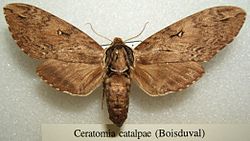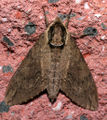- Ceratomia catalpae
-
Catalpa Sphinx Scientific classification Kingdom: Animalia Phylum: Arthropoda Class: Insecta Order: Lepidoptera Family: Sphingidae Genus: Ceratomia Species: C. catalpae Binomial name Ceratomia catalpae
(Boisduval, 1875)[1]Synonyms - Sphinx catalpae Boisduval, 1875
- Ceratomia catalpae kansensis Howe & Howe, 1950
- Ceratomia catalpae kanawahensis Sweadner, Chermock & Chermock, 1940
The Catalpa Sphinx (Ceratomia catalpae) is a hawk moth of the Sphingidae family.
Contents
Range
Ceratomia catalpae is a native of southeastern North America and can be located on catalpa trees that grow within this region. It can be found from Maine, west to Iowa, south to Florida, the gulf states and Texas.
Life cycle
From oviposition of the eggs to pupation, about four weeks will pass. Where multiple broods occur, pupae will eclose in two weeks, or when conditions are suitable. Adult C. catalpae don't reflect the wonderful colors of its larvae. They are a dull brown color lacking that show-off appearance of its larval stages.
Egg
Translucent, milky-white, green, or yellowish eggs are oval, being about .5 mm in diameter. Eggs are deposited in masses of 100-1000 eggs on the undersurface of leaves, while smaller masses are deposited onto branches on the Catalpa tree. Eggs incubate and hatch five to seven days after oviposition.
Larva
The larval stage of C. catalpae is known as the Catalpa or Catawba Worm. When first hatching, the larvae are a very pale color, but become darker toward the last instars. The yellow caterpillars will usually have a dark, black stripe down their back along with black dots along their sides. There is also a "pale" phase where the black striping is not as prevalent or missing altogether and a shade of white has replaced it. They grow to a length of about 5 cm (2 in) and feed on the leaves of the Northern Catalpa and, more commonly, the Southern Catalpa, also known as Catawba or Indian Bean trees. They are highly desired by fishermen as bait.
Pupa
Like most other Sphingidae, Ceratomia catalpae will burrow into the ground after its fifth and final instar in order to pupate. The larvae will go into a "wandering" stage where it leaves the Catalpa tree and climbs to the ground to find a place to bury itself so that it may pupate. The larvae will then shed its fifth instar skin to reveal its pupal skin, which will be soft and almost translucent at first, but will then harden to a light brown for protection from the elements.
Adult
The adult Catalpa Sphinx is brown in color with a circular band of dark brown or black surrounding its thorax. Each forewing has a small, dark mark towards the middle, with a white dot in the cell. The body is approximately 30mm long. The wingspan is 65–95 mm.
Images of Life Cycle
Food Plants
C. catalpae can be quite harmful to the Catalpa tree during large outbreaks. The first trial of aerial crop dusting was an attempt to control the Catalpa Sphinx.
- Catalpa bignonioides, (Southern Catalpa)
- Catalpa speciosa, (Northern Catalpa)
References
- ^ "CATE Creating a Taxonomic eScience - Sphingidae". Cate-sphingidae.org. http://www.cate-sphingidae.org/taxonomy/Ceratomia/catalpae.html. Retrieved 2011-11-01.
External links
- Catalpa sphinx, Moths of North America
- Ceratomia catalpae, Sphingidae of the Americas
Categories:
Wikimedia Foundation. 2010.






